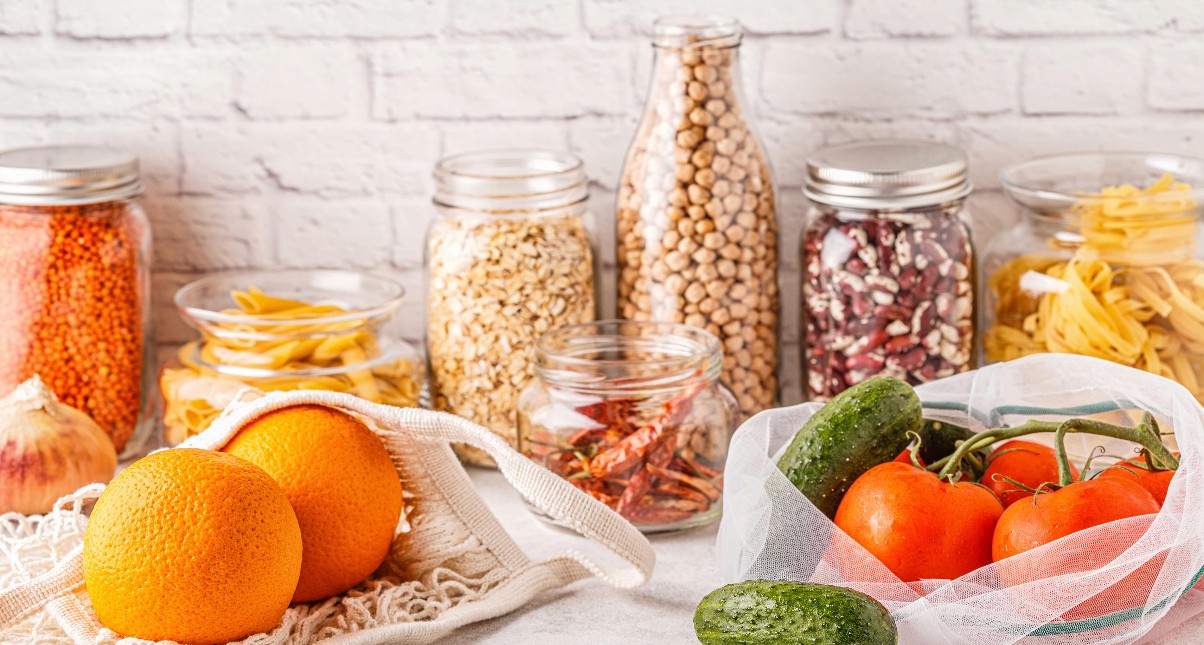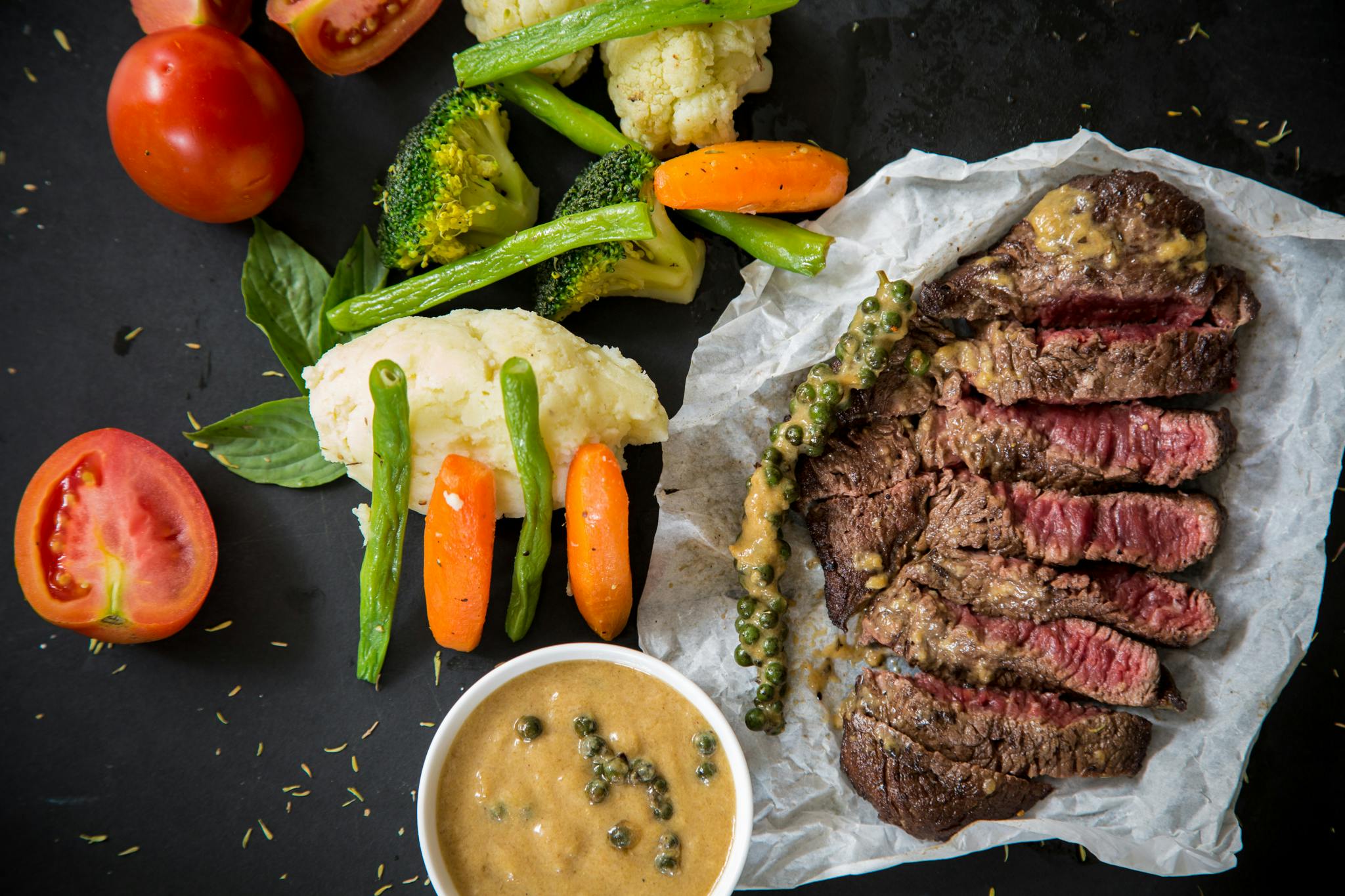Storing fruits and vegetables correctly not only maximizes their freshness, but ensures they stay edible for as long as possible. After all, it’s never fun to open a bag of spinach only to find that the leaves have turned slimy, or bite into a mushy strawberry.
Here’s a guide to help you store your produce, so you can enjoy them for longer and minimize food waste.
Apples and oranges: Store apples and oranges in the produce drawer of your refrigerator. In the fridge they’ll stay fresh for up to a month! If you’re short on fridge space, apples and oranges will do well at room temperature on the counter - just be sure to enjoy them within a week.
Bananas: Keep bananas on the counter at room temperature. If they arrived green, they’ll be yellow and ready to eat within a few days.
Berries: Refrigerate fresh berries like strawberries, blueberries, and raspberries. They’ll stay fresh in the fridge for 3-4 days.
Lemons and limes: Store citrus fruits like lemons and limes in the produce drawer of your fridge. They can last in there for up to a month.
Peaches and nectarines: Peaches and nectarines are both stone fruits. Store them at room temperature until they’re slightly soft to the touch, then transfer to the fridge for up to a week. The cool temperature will slow the fruits from ripening further.
Avocados: Store avocados on the counter until just barely soft to the touch. Another way to tell if an avocado is ripe is to take a peek under the stem. If the stem is easy to remove and the area underneath the stem is green, the avocado is ready. Enjoy right away or store it in the fridge for up to 3 days. If the stem is hard to remove, the avocado needs more time to ripen at room temperature.
Carrots, cucumbers, and peppers: Crunchy vegetables should be kept in the produce drawer of your refrigerator. If your carrots arrived with their green, leafy tops, be sure to cut those off before storing.
Hearty greens: Keep heartier greens like collard greens, kale, and cabbage in the produce drawer of your refrigerator. They'll last for up to a week.
Herbs: Wash soft herbs like parsley, cilantro, dill, and mint, then dry them completely. Wrap the herbs in a paper towel, then store in a resealable bag in the produce drawer of your refrigerator. The paper towel will absorb any excess moisture and keep the herbs fresh and ready for up to a week. Treat hearty herbs, like rosemary and thyme, in the same way and they'll last for up to 2 weeks.
Lettuce: Keep crunchy lettuces, like romaine or Boston leaf, in the produce drawer of your refrigerator. Keep leafy greens, like spinach, arugula, and mixed greens, on a shelf in the fridge. Add a paper towel to the container with the leafy greens to absorb any extra moisture and keep them fresh.
Onions, garlic, and ginger: Store aromatics like onions, garlic, and ginger in a bowl at room temperature on your counter.
Potatoes: Potatoes prefer a cool, dark space to stay firm and fresh. Store in a closed cabinet if you have the space, just don’t forget them there!
Prepared vegetables: Always store pre-cut vegetables like diced onions, minced garlic, or cubed squash in the refrigerator. Their shelf life is shorter because they’re pre-cut, so keep them toward the front of your refrigerator so they’re not forgotten.
Tomatoes: Keep fresh tomatoes on the counter for up to a week.
Storing fruits and vegetables correctly not only maximizes their freshness, but ensures they stay edible for as long as possible. After all, it’s never fun to open a bag of spinach only to find that the leaves have turned slimy, or bite into a mushy strawberry.
Here’s a guide to help you store your produce, so you can enjoy them for longer and minimize food waste.
Apples and oranges: Store apples and oranges in the produce drawer of your refrigerator. In the fridge they’ll stay fresh for up to a month! If you’re short on fridge space, apples and oranges will do well at room temperature on the counter - just be sure to enjoy them within a week.
Bananas: Keep bananas on the counter at room temperature. If they arrived green, they’ll be yellow and ready to eat within a few days.
Berries: Refrigerate fresh berries like strawberries, blueberries, and raspberries. They’ll stay fresh in the fridge for 3-4 days.
Lemons and limes: Store citrus fruits like lemons and limes in the produce drawer of your fridge. They can last in there for up to a month.
Peaches and nectarines: Peaches and nectarines are both stone fruits. Store them at room temperature until they’re slightly soft to the touch, then transfer to the fridge for up to a week. The cool temperature will slow the fruits from ripening further.
Avocados: Store avocados on the counter until just barely soft to the touch. Another way to tell if an avocado is ripe is to take a peek under the stem. If the stem is easy to remove and the area underneath the stem is green, the avocado is ready. Enjoy right away or store it in the fridge for up to 3 days. If the stem is hard to remove, the avocado needs more time to ripen at room temperature.
Carrots, cucumbers, and peppers: Crunchy vegetables should be kept in the produce drawer of your refrigerator. If your carrots arrived with their green, leafy tops, be sure to cut those off before storing.
Hearty greens: Keep heartier greens like collard greens, kale, and cabbage in the produce drawer of your refrigerator. They'll last for up to a week.
Herbs: Wash soft herbs like parsley, cilantro, dill, and mint, then dry them completely. Wrap the herbs in a paper towel, then store in a resealable bag in the produce drawer of your refrigerator. The paper towel will absorb any excess moisture and keep the herbs fresh and ready for up to a week. Treat hearty herbs, like rosemary and thyme, in the same way and they'll last for up to 2 weeks.
Lettuce: Keep crunchy lettuces, like romaine or Boston leaf, in the produce drawer of your refrigerator. Keep leafy greens, like spinach, arugula, and mixed greens, on a shelf in the fridge. Add a paper towel to the container with the leafy greens to absorb any extra moisture and keep them fresh.
Onions, garlic, and ginger: Store aromatics like onions, garlic, and ginger in a bowl at room temperature on your counter.
Potatoes: Potatoes prefer a cool, dark space to stay firm and fresh. Store in a closed cabinet if you have the space, just don’t forget them there!
Prepared vegetables: Always store pre-cut vegetables like diced onions, minced garlic, or cubed squash in the refrigerator. Their shelf life is shorter because they’re pre-cut, so keep them toward the front of your refrigerator so they’re not forgotten.
Tomatoes: Keep fresh tomatoes on the counter for up to a week.
Storing fruits and vegetables correctly not only maximizes their freshness, but ensures they stay edible for as long as possible. After all, it’s never fun to open a bag of spinach only to find that the leaves have turned slimy, or bite into a mushy strawberry.
Here’s a guide to help you store your produce, so you can enjoy them for longer and minimize food waste.
Apples and oranges: Store apples and oranges in the produce drawer of your refrigerator. In the fridge they’ll stay fresh for up to a month! If you’re short on fridge space, apples and oranges will do well at room temperature on the counter - just be sure to enjoy them within a week.
Bananas: Keep bananas on the counter at room temperature. If they arrived green, they’ll be yellow and ready to eat within a few days.
Berries: Refrigerate fresh berries like strawberries, blueberries, and raspberries. They’ll stay fresh in the fridge for 3-4 days.
Lemons and limes: Store citrus fruits like lemons and limes in the produce drawer of your fridge. They can last in there for up to a month.
Peaches and nectarines: Peaches and nectarines are both stone fruits. Store them at room temperature until they’re slightly soft to the touch, then transfer to the fridge for up to a week. The cool temperature will slow the fruits from ripening further.
Avocados: Store avocados on the counter until just barely soft to the touch. Another way to tell if an avocado is ripe is to take a peek under the stem. If the stem is easy to remove and the area underneath the stem is green, the avocado is ready. Enjoy right away or store it in the fridge for up to 3 days. If the stem is hard to remove, the avocado needs more time to ripen at room temperature.
Carrots, cucumbers, and peppers: Crunchy vegetables should be kept in the produce drawer of your refrigerator. If your carrots arrived with their green, leafy tops, be sure to cut those off before storing.
Hearty greens: Keep heartier greens like collard greens, kale, and cabbage in the produce drawer of your refrigerator. They'll last for up to a week.
Herbs: Wash soft herbs like parsley, cilantro, dill, and mint, then dry them completely. Wrap the herbs in a paper towel, then store in a resealable bag in the produce drawer of your refrigerator. The paper towel will absorb any excess moisture and keep the herbs fresh and ready for up to a week. Treat hearty herbs, like rosemary and thyme, in the same way and they'll last for up to 2 weeks.
Lettuce: Keep crunchy lettuces, like romaine or Boston leaf, in the produce drawer of your refrigerator. Keep leafy greens, like spinach, arugula, and mixed greens, on a shelf in the fridge. Add a paper towel to the container with the leafy greens to absorb any extra moisture and keep them fresh.
Onions, garlic, and ginger: Store aromatics like onions, garlic, and ginger in a bowl at room temperature on your counter.
Potatoes: Potatoes prefer a cool, dark space to stay firm and fresh. Store in a closed cabinet if you have the space, just don’t forget them there!
Prepared vegetables: Always store pre-cut vegetables like diced onions, minced garlic, or cubed squash in the refrigerator. Their shelf life is shorter because they’re pre-cut, so keep them toward the front of your refrigerator so they’re not forgotten.
Tomatoes: Keep fresh tomatoes on the counter for up to a week.
Storing fruits and vegetables correctly not only maximizes their freshness, but ensures they stay edible for as long as possible. After all, it’s never fun to open a bag of spinach only to find that the leaves have turned slimy, or bite into a mushy strawberry.
Here’s a guide to help you store your produce, so you can enjoy them for longer and minimize food waste.
Apples and oranges: Store apples and oranges in the produce drawer of your refrigerator. In the fridge they’ll stay fresh for up to a month! If you’re short on fridge space, apples and oranges will do well at room temperature on the counter - just be sure to enjoy them within a week.
Bananas: Keep bananas on the counter at room temperature. If they arrived green, they’ll be yellow and ready to eat within a few days.
Berries: Refrigerate fresh berries like strawberries, blueberries, and raspberries. They’ll stay fresh in the fridge for 3-4 days.
Lemons and limes: Store citrus fruits like lemons and limes in the produce drawer of your fridge. They can last in there for up to a month.
Peaches and nectarines: Peaches and nectarines are both stone fruits. Store them at room temperature until they’re slightly soft to the touch, then transfer to the fridge for up to a week. The cool temperature will slow the fruits from ripening further.
Avocados: Store avocados on the counter until just barely soft to the touch. Another way to tell if an avocado is ripe is to take a peek under the stem. If the stem is easy to remove and the area underneath the stem is green, the avocado is ready. Enjoy right away or store it in the fridge for up to 3 days. If the stem is hard to remove, the avocado needs more time to ripen at room temperature.
Carrots, cucumbers, and peppers: Crunchy vegetables should be kept in the produce drawer of your refrigerator. If your carrots arrived with their green, leafy tops, be sure to cut those off before storing.
Hearty greens: Keep heartier greens like collard greens, kale, and cabbage in the produce drawer of your refrigerator. They'll last for up to a week.
Herbs: Wash soft herbs like parsley, cilantro, dill, and mint, then dry them completely. Wrap the herbs in a paper towel, then store in a resealable bag in the produce drawer of your refrigerator. The paper towel will absorb any excess moisture and keep the herbs fresh and ready for up to a week. Treat hearty herbs, like rosemary and thyme, in the same way and they'll last for up to 2 weeks.
Lettuce: Keep crunchy lettuces, like romaine or Boston leaf, in the produce drawer of your refrigerator. Keep leafy greens, like spinach, arugula, and mixed greens, on a shelf in the fridge. Add a paper towel to the container with the leafy greens to absorb any extra moisture and keep them fresh.
Onions, garlic, and ginger: Store aromatics like onions, garlic, and ginger in a bowl at room temperature on your counter.
Potatoes: Potatoes prefer a cool, dark space to stay firm and fresh. Store in a closed cabinet if you have the space, just don’t forget them there!
Prepared vegetables: Always store pre-cut vegetables like diced onions, minced garlic, or cubed squash in the refrigerator. Their shelf life is shorter because they’re pre-cut, so keep them toward the front of your refrigerator so they’re not forgotten.
Tomatoes: Keep fresh tomatoes on the counter for up to a week.
Storing fruits and vegetables correctly not only maximizes their freshness, but ensures they stay edible for as long as possible. After all, it’s never fun to open a bag of spinach only to find that the leaves have turned slimy, or bite into a mushy strawberry.
Here’s a guide to help you store your produce, so you can enjoy them for longer and minimize food waste.
Apples and oranges: Store apples and oranges in the produce drawer of your refrigerator. In the fridge they’ll stay fresh for up to a month! If you’re short on fridge space, apples and oranges will do well at room temperature on the counter - just be sure to enjoy them within a week.
Bananas: Keep bananas on the counter at room temperature. If they arrived green, they’ll be yellow and ready to eat within a few days.
Berries: Refrigerate fresh berries like strawberries, blueberries, and raspberries. They’ll stay fresh in the fridge for 3-4 days.
Lemons and limes: Store citrus fruits like lemons and limes in the produce drawer of your fridge. They can last in there for up to a month.
Peaches and nectarines: Peaches and nectarines are both stone fruits. Store them at room temperature until they’re slightly soft to the touch, then transfer to the fridge for up to a week. The cool temperature will slow the fruits from ripening further.
Avocados: Store avocados on the counter until just barely soft to the touch. Another way to tell if an avocado is ripe is to take a peek under the stem. If the stem is easy to remove and the area underneath the stem is green, the avocado is ready. Enjoy right away or store it in the fridge for up to 3 days. If the stem is hard to remove, the avocado needs more time to ripen at room temperature.
Carrots, cucumbers, and peppers: Crunchy vegetables should be kept in the produce drawer of your refrigerator. If your carrots arrived with their green, leafy tops, be sure to cut those off before storing.
Hearty greens: Keep heartier greens like collard greens, kale, and cabbage in the produce drawer of your refrigerator. They'll last for up to a week.
Herbs: Wash soft herbs like parsley, cilantro, dill, and mint, then dry them completely. Wrap the herbs in a paper towel, then store in a resealable bag in the produce drawer of your refrigerator. The paper towel will absorb any excess moisture and keep the herbs fresh and ready for up to a week. Treat hearty herbs, like rosemary and thyme, in the same way and they'll last for up to 2 weeks.
Lettuce: Keep crunchy lettuces, like romaine or Boston leaf, in the produce drawer of your refrigerator. Keep leafy greens, like spinach, arugula, and mixed greens, on a shelf in the fridge. Add a paper towel to the container with the leafy greens to absorb any extra moisture and keep them fresh.
Onions, garlic, and ginger: Store aromatics like onions, garlic, and ginger in a bowl at room temperature on your counter.
Potatoes: Potatoes prefer a cool, dark space to stay firm and fresh. Store in a closed cabinet if you have the space, just don’t forget them there!
Prepared vegetables: Always store pre-cut vegetables like diced onions, minced garlic, or cubed squash in the refrigerator. Their shelf life is shorter because they’re pre-cut, so keep them toward the front of your refrigerator so they’re not forgotten.
Tomatoes: Keep fresh tomatoes on the counter for up to a week.





